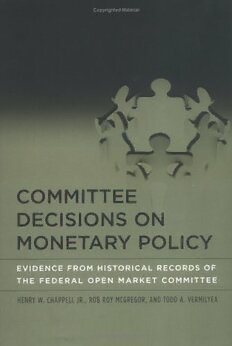
Committee Decisions on Monetary Policy: Evidence from Historical Records of the Federal Open Market Committee PDF
333 Pages·2004·3.417 MB·English
Most books are stored in the elastic cloud where traffic is expensive. For this reason, we have a limit on daily download.
Preview Committee Decisions on Monetary Policy: Evidence from Historical Records of the Federal Open Market Committee
Description:
In many countries, monetary policy decisions are made by committees. In the United States, these decisions are made by the Federal Reserve's Federal Open Market Committee (FOMC), which consists of the seven members of the Board of Governors and the presidents of the twelve district banks. This book examines the process by which the preferences of the FOMC's individual members are translated into collective policy choices. This focus on the aggregation of individual preferences into group decisions is unique and provides an important perspective on the evolution of monetary policy choices.To study decision making by the FOMC, the authors have used both formal voting records and detailed transcripts and summaries of deliberations contained in the committee's Memoranda of Discussion and FOMC Transcripts. The latter sources have been used to construct data sets describing individual committee members' policy preferences for the 1970-1978 and 1987-1996 periods when the FOMC was chaired by Arthur Burns and Alan Greenspan, respectively. These data are used to estimate monetary policy reaction functions for individual Committee members and to explore the role of majoritarian pressures, pressures for consensus, and the power of the chairman in collective decision making. The rich anecdotal evidence found in the Memoranda of Discussion and FOMC Transcripts inspires the narrative approach taken in two chapters, on the influence of political pressure on FOMC deliberations and on the relevance of the time inconsistency problem for the rise of inflation in the 1970s.
See more
The list of books you might like
Most books are stored in the elastic cloud where traffic is expensive. For this reason, we have a limit on daily download.
